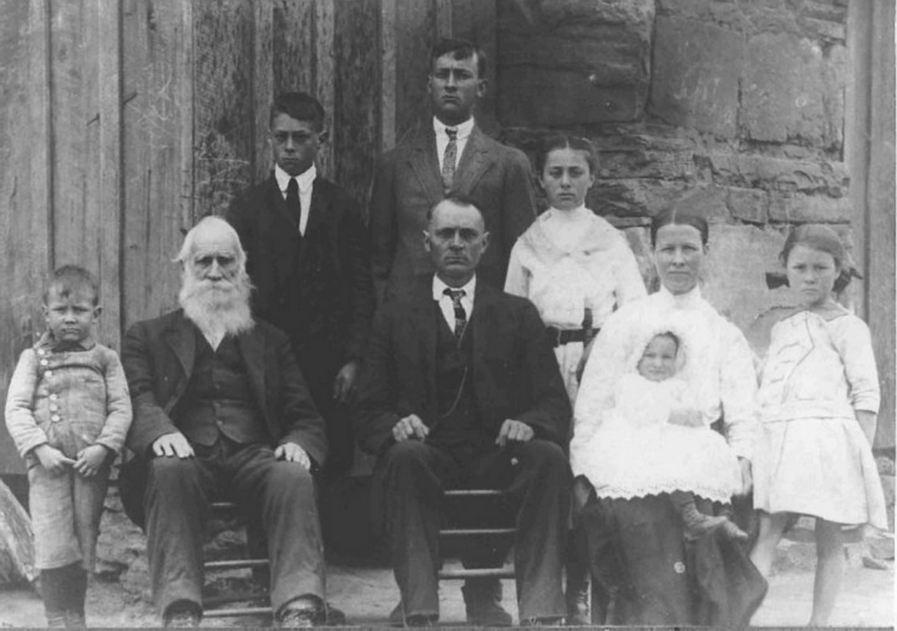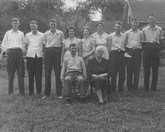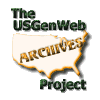Introducing our
Contestants
You will frequently see
these terms to distinguish what kind of source
was used for a particular piece of information
or to identify a source itself. Essentially, a
Primary Source was created by
someone who was there. These include diaries,
letters, court records, business records,
census records and countless other documents.
Some occur as the event actually happens, such
as a purchase receipt. Some are actually
recorded after the event. For example, a doctor
shouldn’t be filling out the birth certificate
as the child is born. He needs to finish he
job, clean up a bit, and then pull out the pen.
Length of time between the event and the record
varies. But in all cases the person behind the
pen was there. Secondary
Sources are everything else. These
range from classic history texts to your
personal genealogy database. Here, the person
behind the pen wasn’t actually there. Instead,
the individual has compiled information from
various sources to complete the
information.
Determining if a source is
primary or secondary can be pretty
tricky. For example, newspapers can be
both primary and secondary sources. During
the American Bicentennial, the Transylvania
Times reported many local events to
celebrate the occasion. The reporter was
actually there, becoming the “pen” for
participants to record the event. These
articles are primary sources. Likewise,
throughout the year, the newspaper published
several articles bout the history of
Transylvania County. Many of these dealt
with topics for which all participants are
deceased. As a result, these articles are
secondary sources. A Federal Census record
is considered a primary source. A
transcription of that census is considered a
secondary source since the transcriber has an
opportunity to add additional research –
hopefully clarifying which is from the document
and which is from elsewhere – as well as add
additional errors. Interestingly, even
though the actual Federal Census microfilm is
considered a primary source, these records are
actually transcriptions of the state
copy. This detail is generally allowed to
slide since there weren’t photocopiers
available at the time. Researchers should
simply keep in mind that yet another
opportunity for error was involved. To further
complicate matters, some academic editions of
transcribed manuscripts are of such good
quality and contain so much additional
editorial information they are "promoted" to a
"Published Primary Source" in bibliographies
used in academic research.
Round One -
Primary Sources
Primary Sources are generally considered to
be more reliable than secondary sources. But
this is not always the case. People make
mistakes, or their memory gets a little soft,
or, on occasion, they just point blank lie. One
primary source alone should never be considered
as absolute proof of anything. Users should
carefully consider the context of the document
and the author. A birth certificate was
completed by the doctor immediately following
the birth. Short of deliberate fraud, we can be
certain the identity of the mother and child is
correct. But what about the father? The doctor
wasn’t there at conception. Likewise personal
memoirs of events can add new personal
interpretations of events that would be far
different than say a diary or letter written as
it happened. Census records are notorious for
errors for a multitude of reasons. Any set of
application involving personal gain, such a
revolutionary war grant and Cherokee
enrollments will generally contain some degree
of fraud. And we have all experienced getting
the details about something a bit mixed up at
points. Another significant factor,
particularly in older newspaper accounts, is
the bias of the author. In Western North
Carolina newspapers at the beginning of the
20th century pretty much
carried a strong Democratic Party bias. Reports
of various party politics reflect this. When
reading today’s news readers hopefully take
these editorial biases into account. We should
do the same when reading information from older
sources.
Round Two -
Secondary Sources
When done well, secondary
sources can help evaluate primary sources by
providing historic context and alternative
views of events. When done poorly,
secondary sources can send researchers in the
wrong direction or in the worse case scenario
result in poor public policy decisions
concerning historic resources. Again,
readers should carefully consider the source
before evaluating its value to current
research. Secondary Sources should include
the sources for the
research. Unfortunately, many beginning
researchers are not aware of the importance of
sources – though they tend to regret not having
taken better source notes later on. Also,
many publishers try to cut costs by not
including source information. If enough
disappointed readers write the publishers about
this omission, this trend will change. Until
then, this practice greatly hinders future
research. The background of the author is
important as well. Professional historians
will have a much deeper understanding of the
historic context and important issues that may
be involved. This is important when dealing
with larger topics. A good family
historian will have much better information on
a particular family and the events that shaped
their lives. The source information and
background of the researcher help readers
evaluate the usefulness of the work.
And the Winner
is?
So which kind of source is
better? Neither. Good research will
always involve a combination of sources. Book
reviews and annotated bibliographies contain
information about the strengths and weaknesses
of a work as part of this evaluation and are
meant only to help place the work within the
whole body of available research, not praise or
condemn the author. Edited versions of
primary documents add crucial information in
evaluating original source material. What
is crucial is to allow the often conflicting
information to tell its own story. One of
the most common mistakes in genealogy is to
simplify the discrepancies by dismissing
information as erroneous in order to support a
predetermined conclusion. In Western North
Carolina research as frequent example of this
is the conclusion that an individual settled in
one of the far western counties earlier than he
actually did – assuming quirks in the early
documents. More
often the ancestor actually migrated west in
steps. It is easy to make such
assumptions. And erroneous assumptions can
lead to years of misplaced research following
the wrong interpretation of events.
We live in a complicated
world filled with complicated
people. Events were no less complicated in
the past. Ultimately, each researcher
should constantly seek all information
available on a topic and then add their own
research for the next researcher who joins in
the never ending process of understanding our
past.
- Linda Hoxit Raxter,
originally posted January 4, 2003
^ Back
to Top
|






